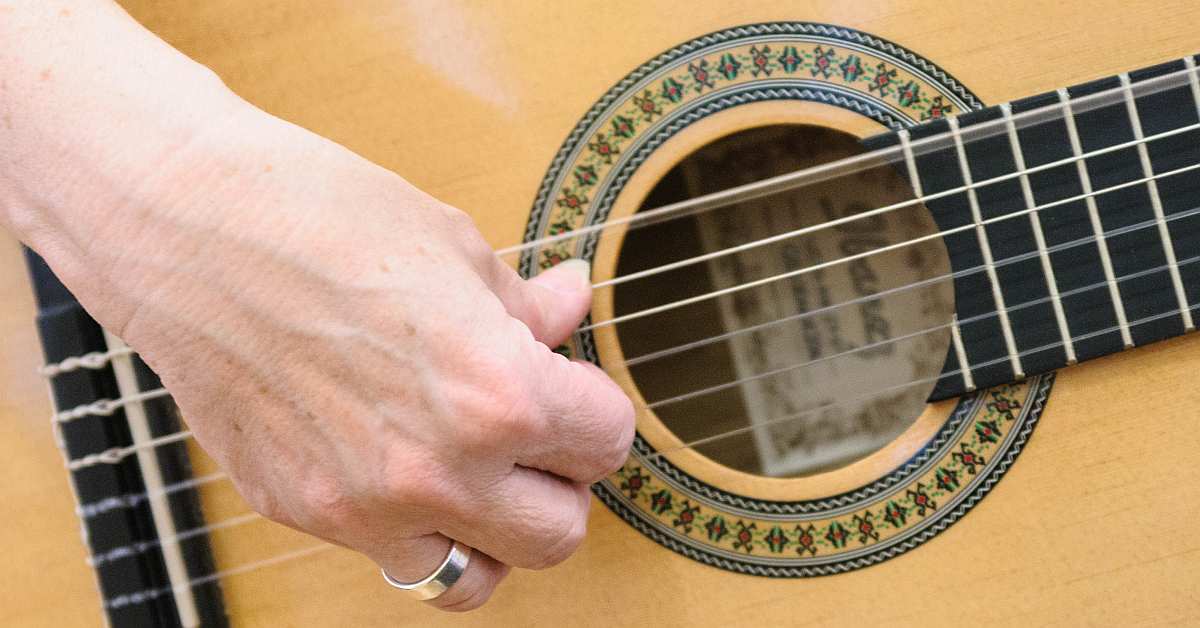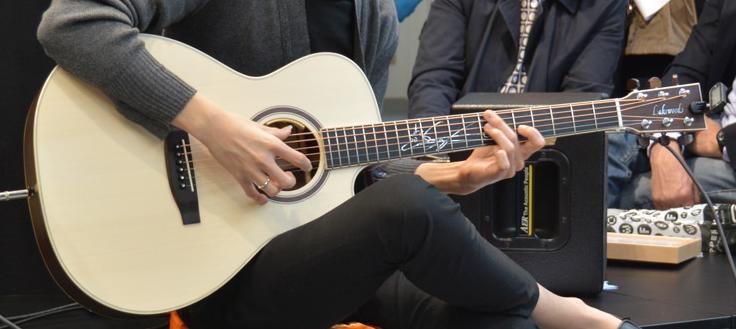Explore the differences between classical or "classic" guitar and fingerpicking or fingerstyle guitar.
Wondering what the difference is between fingerstyle guitar and classical guitar? Before we get started, I need to make a disclaimer. I'm a classically trained guitarist.
But, before you go running for the hills, let me point out that when I discovered fingerstyle guitar, I became hooked.
So, I became a fingerstyle guitarist. And luckily for me, fingerstyle is much more similar to classical guitar than flamenco.
So, let's dive in deep to exploring the difference between classical guitar (or "classic guitar" as your grandpa would say), and fingerstyle, or finger picking guitar.
What's The Difference Between Classical Guitar and Fingerstyle Guitar?
Since fingerstyle refers to playing the guitar with the fingers, you may be tempted to think of classical guitar as being a derivative genre of fingerstyle guitar. But this is totally not the case.
Classical guitar is part of a broader genre known as Western classical music or art music. On the other hand, fingerstyle refers to the jazz or pop player who plays guitar with the fingers instead of the flatpick.
When I, as a classical guitarist, first attempted to transition into fingerstyle playing, it took me some time to loosen up and get my playing to sound, well, less stiff.
On the other hand, when a fingerstyle guitarist plays classical music, it's a little like a punk rock musician who wears formal clothing for the first time.
If you don't believe me, here's Tommy Emmanuel playing Antonio Lauro in front of a group of somewhat bemused classical musicians.
Classical guitarists emphasize proper posture and formal training. We'll delve into that later, but for now, let's look at the similarities between classical guitar and fingerstyle guitar.
Similarities Between Classical Guitar and Fingerstyle Guitar
Beyond the obvious, that both playing styles involve plucking the guitar with the fingers instead of using a pick, here are some other similarities between these two playing styles.
Playing Technique
As you are likely already aware, both classical and fingerstyle technique involve precise fingerpicking, where each finger has a specific role assigned to it. The thumb generally handles the bass notes, while the other fingers take care of melody, harmony, and accompaniment.
Both classical and fingerstyle guitarists rely heavily on the plucking technique known as free stroke or tirando. This is in contrast to flamenco or electric bass players who use rest stroke or apoyando for the majority of their playing.

Fingernails
Both classical and fingerstyle guitar are effective and can be played with or without fingernails. In my opinion, classical guitar music, played sensitively without nails, sounds fantastic. But growing your nails out can help with tone quality and note precision.
Advanced techniques
Although it's fashionable to think that extended techniques such as percussive slaps, palm muting, harmonics, and alternate tunings are exclusively the domain of fingerstyle guitar, this isn't the case.
Both contemporary classical guitarists and composers from earlier periods have incorporated these elements into their compositions. In fact, Drop D tuning is common in simple classical guitar repertoire because it allows for playing in D major and using the lowest string as a drone.
Learning new songs and practice
Both classical and fingerstyle guitarists primarily focus on written sheet music as a means of learning new songs, although some fingerstyle guitarists cannot read music and rely on learning by ear and improvisation.
In addition, modern fingerstyle and classical guitar players both create their own compositions and arrangements for the guitar. Interestingly enough, other classically trained musicians, with the exception of pianists, don't typically create their own compositions.
Differences Between Classical Guitar and Fingerstyle Guitar
Classical guitar also has several features that distinguishes it from fingerstyle guitar. From playing habits to music, here are some important differences between classical and fingerstyle guitar.
Acoustic Guitar Choice
The most obvious difference between fingerstyle and classical guitar is the choice of instrument. Classical guitarists exclusively play on a classical guitar, sitting using a footstool or, more rarely, a classical guitar strap.

Fingerstyle guitarists can, and often do, play on steel string guitars as well as on nylon string or classical guitars. But classical guitarists almost never play their repertoire on a steel string guitar.
By the way, when a fingerstyle guitarist refers to a nylon string guitar, don't be tempted to think this automatically refers to a classical guitar. There are nylon string guitars which have the same body shape as an acoustic, and the internal construction is very different.
Although fingerstyle guitarists play on all types of steel string guitars, smaller body guitar shapes such as the parlor or concert shapes are more popular. Indeed, the cutaway guitar body shape is popular among many fingerstyle guitarists, such as Sungha Jung.

Classical guitarists are very careful to never dent or damage their instrument. Some fingerstyle guitarists aren't so careful with their guitars.
Repertoire
Modern classical guitarists have a repertoire that is typically more dissonant and contemporary than fingerstyle guitarists, whose repertoire draws from pop, blues and jazz.
Classical guitar composers
Classical guitarists are very familiar with composers like Bach, Beethoven and the boys, who were unquestionably the grand masters of their period, although they wrote very little guitar music (or none at all). Instead, classically trained violinists and pianists choose to adhere to traditional repertoire, which is vast in comparison to classical guitar.
Luckily, classical guitarists have their own composers like Sor, Coste and Tarrega from that period who wrote plenty of beautiful music for the classical guitar.
Tone Quality
Classical guitarists place much more emphasis on mellow, dark tone, whereas fingerstyle guitarists in general prefer a brighter sound from their instruments.
Training
Classical guitarists generally place a lot of emphasis on formal training, whereas many fingerstyle guitarists claim to be self taught. I say claim because there are lots of resources to learn fingerstyle guitar nowadays that don't involve the traditional setting with a private tutor.
That said, I think there is an enormous advantage in formal training.
Is Fingerstyle Guitar Harder Than Playing Classical Guitar?
No, fingerstyle guitar isn’t necessarily harder than playing classical guitar. There are very easy and very difficult fingerpicking songs, just as there are easy and difficult classical pieces that you can play.
And if you are interested in getting started with fingerstyle guitar, I recommend my complete online course, Play Fingerstyle Guitar Now!



